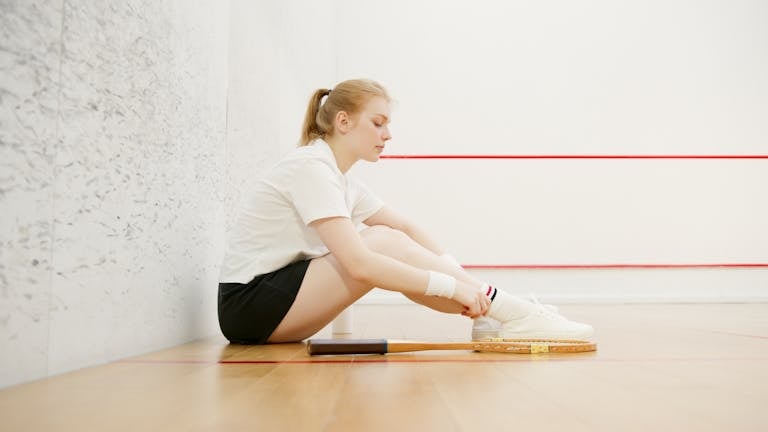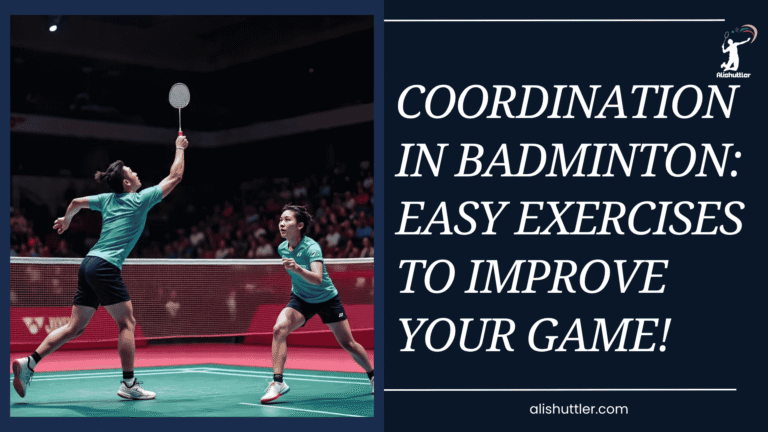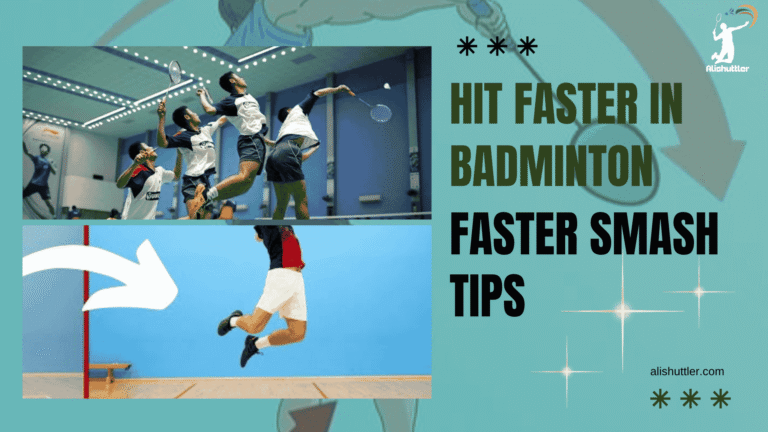Badminton rules in doubles establish the fundamentals for two-player teams to engage in equitable and fluid matches. Each side has two players who both stand on their side of the court, and matches are governed by specific serving, scoring, and court line rules.
Doubles matches typically are more rapid and require immediate coordination. Understanding these rules ensures players don’t get caught in faults and play confidently. The following sections simplify essential rules and pointers for doubles games.
The Service Court

The service court in doubles badminton is crucial for gameplay. A typical badminton court is 13.4 meters long and 6.1 meters wide. The court has designated serving areas, with each side having two service courts – left and right. Players serve from these areas, with strict rules about their feet, serve direction, and shuttle height.
The net is 1.55m high, which defines the flight and strategies of each serve. Knowing these court sections and regulations is important for precision and legality during games.
The Boundaries
The outermost boundary lines on a doubles court define the playable area. Badminton rules for doubles, the back boundary and side lines are different than singles because they include the side tramlines. If these lines are missed, the shuttlecock is out, causing a fault.
Knowing which lines are live is critical in singles and doubles, as it shifts your tactics and movement around the court. Doubles players have to be extra careful about the wider court when defending smashes or chasing down low serves near the sidelines.
Players love to use these boundaries to create acute angles and induce mistakes. For instance, a serve near the sideline or a drop shot just inside the back boundary can keep your opponents on their toes. Smashing by the rail can take points, but it’s dangerous—accuracy is essential.
Line crossing or touching has a very obvious consequence: the loss of a rally. If the shuttle lands beyond or doesn’t land at all on the correct line, it’s a fault. This harshness maintains equitable matches and honors cautious play.
The Center Line
The center line on a badminton court divides each side’s service court into left and right halves, determining where servers and receivers must stand. This directs players to serve cross-court, adhering to the rule that first serves—and every serve from an even score—are served from the right side. In badminton doubles, serving strategies center around the center line, allowing teams to set up strategically serves to surprise opponents in these designated areas.
When playing badminton, players must adhere to the service rules, which dictate that they cannot touch or cross the center line. Both the server and receiver must keep at least half of one foot on the court and remain stationary until the serve is executed. These regulations are crucial in maintaining fairness in the sport and ensuring that all players respect the court lines.
The center line’s role in fair play is essential in badminton. It makes serves predictable and compels both parties to honor the court’s anatomy, which helps keep chaos at bay during intense doubles exchanges. By understanding these basic strategies, players can enhance their game and improve their chances of winning.
In conclusion, mastering the center line and service rules is vital for success in badminton. These elements not only ensure fairness but also elevate the quality of play, allowing teams to engage in thrilling matches while showcasing their skills and strategies effectively.
The Doubles Serve

The doubles serve in badminton has a couple of distinct rules and technical nuances that differentiate it from singles. Each player needs to be mindful of serving order, court positions and other regulations that keep the game fair and fast.
Below is a table summarizing key rules exclusive to doubles:
| Doubles Serve Rule | Key Details |
|---|---|
| Serve Direction | Always served diagonally across to the opponent’s service box |
| Service Box | Changes based on server’s score (even = right, odd = left) |
| Serve Height Limit | Shuttle must be struck below 1.15 meters from court surface |
| Server and Receiver Stillness | Both must be stationary until the shuttle is struck |
| Faults Allowed | Only two faults per game before losing the serve |
| Racket Motion | Forward swing starts only when both sides are ready |
1. Server’s Position
When serving the ball, the server shall stand within his or her service box, without touching the lines bounding it. Both feet must be on the floor and stationary until the shuttle is struck.
Raising or dragging a foot prior to hitting the shuttle is a fault. The correct position prevents faults and provides the server with power over the shuttle’s trajectory and velocity.
Keeping balanced keeps the server focused. A nice set with your knees bent and weight equalized can save a slip-up. The stance of the server on the doubles alley has an impact on the power or spin applied, which can make all the difference in the rally!
2. Receiver’s Position
The receiver must stand in their own diagonal service box and cannot move until the shuttle is served. It keeps the game honest, and it really is a fast reaction to the serve.
A low, ready position with the racket out in front and knees bent allows the receiver to move in any direction. Receivers that chatter with their partner prior to the serve can more effectively strategize how to cover the court post-return.
Observing the server’s stance can assist in predicting whether a short or flick serve is approaching. Little signals, such as the way the server grips the racket, can provide hints for a speedier reaction.
3. Partner Positioning
In doubles, you have one man (or woman) on the front of the court and one on the back. This “front-back” formation aids in court coverage and shot response.
Partners have to shift and switch as the rally continues, sometimes moving side by side, or swapping front and back positions. Both players must remain agile and coordinate their efforts to slide seamlessly.
In the right spot, it means less open spaces for the opposing team to target. Great partners communicate frequently, call shots and shift positions as the shuttle travels.
4. The Correct Box
Serving out of the appropriate box is essential. They must serve from the right when their score is even, left when it’s odd. Serving from the wrong box can be a fault, and can lose them a point or the serve.
Looking at the scoreboard before each serve saves players from mix-ups. The ump likes to see right box usage as well and can jump in if there is a mistake. They should have a habit of double checking positions prior to every serve.
5. The Sequence
Serving order follows the score: even means the right service court, odd means the left. Teams alternate servers after each ‘rally won’. Missing the order or serving out of turn = fault.
Players can rely on easy memory joggers, such as looking at the score before serving. Some teams designate a player to monitor turn order. Adhering to the proper sequence makes matches flow and ensures score clarity.
Scoring and Rotation

Badminton doubles uses a point rally system to determine the pace and flow of the game on the badminton court. Rallies conclude in a point, making every serve crucial. With its own scoring, serving, and rotating rules, teams must remain agile, as scoring by each point influences strategy and teamwork in this beautiful sport.
- Doubles matches adopt rally point scoring to 21 points per game.
- A team has to be up by 2 in order to win, except at 29-29, first to 30 wins.
- Every rally, even when serving, counts a point for the winner.
- The server’s position depends on the score: right side for even, left side for odd.
- Players switch with their partner after scoring on their serve.
- Matches are best of three and teams switch sides after every game and at 11 in the third.
- Every point impacts strategy, court positioning, and momentum.
Even Score
Whenever the score is even – 0, 2, 4, 6 – the server stands on the right service court. It’s the same rule for all even points. Doubles teams have to keep an eye on the score to serve from the correct position. That’s what staying sharp here prevents you from handing out cheap points.
Missing the right place can cost a rally. For example, if the server lines up on the left when it’s 8, the umpire will fault him and the other team gets the point. Teams need to coordinate their movement on the court. The server’s partner flanks left, poised to strike or guard. Concentration is essential.
In quick rallies, following positions and scores assists teams maintain pressure on the opposition. A few teams have signals or quick calls to remind one another of the proper court, particularly following a run of fast points.
Odd Score
| Server’s Score | Serving Position | Example |
|---|---|---|
| Odd | Left court | 1, 3, 5 |
If the score is odd, the server goes to the left service court. The rotation changes the routine. This shift can disrupt the opposing team’s flow. Each player has to adapt their positioning and footwork because angles for serves and returns change. For some reason, serving from the left usually alters the strategy for both sides.
The teams who score well can leverage this to their advantage. For instance, rotating to the left service court at 15-14 can create new angles for a short serve or fast flick. Rotating receivers frequently allows the squad to attack a less experienced receiver, or disrupt the enemy’s setup.
Winning Points
A team scores a point if it wins the rally, regardless of which team served. That implies that each shot counts, and nobody can take it easy. Points are won by forcing errors, dropping a shuttle in bounds, or surprising the opponents with lightning-quick reflexes.
Winning points isn’t all skill–position, teamwork, and timing are just as important. Each point pushes the team closer to 21, but the pressure mounts as the score increases. At 20-20 every rally is vital, and teams have to manage nerves.
Units who fight as a unit—covering for each other, calling shots—can tilt a tight game in their direction. Squads attempt to score points by targeting holes, varying pace, and preparing for smashes or drops. Well-matched pairs communicate, observe the shuttle, and adjust strategies if necessary. The tighter the score, the more brilliant play and good teamwork count.
Common Faults

Badminton doubles is packed with rapid action and instantaneous decisions. Knowing faults allows teams to keep play fair and not cheap points. A few faults are simple to identify, but most require keen observation and an understanding of the rules.
Below are the most common faults seen in doubles matches:
- Serving from outside the service box
- Moving before the server hits the shuttlecock
- Delaying the serve too long
- Double-hitting the shuttlecock
- Touching the net with the body or racket
- Obstructing an opponent’s swing or view
- Hitting the shuttlecock before it crosses the net
- Receiving serve in the wrong service court
Faults usually signify a lost rally, and hence the point to the other side. Games are to twenty-one with a two-point lead required, so every fault can turn momentum. By understanding these faults and how to avoid them, players can reduce errors, maintain rally length and play a more intelligent game.
Service Faults
Service faults can occur if the server violates serving regulations, particularly when playing badminton. This includes serving from beyond the service box, striking the birdie below the waist, or executing a late serve. Additionally, serving before the adversaries are prepared or making a premature move constitutes a fault as well.
If the server’s foot steps on or over the court lines, or if the shuttle is struck above the waist, the serve is deemed a fault, resulting in a point for the opposing team. Such blunders can be detrimental, causing the server’s side to lose vital points in badminton singles or doubles matches.
To prevent service faults, players can focus on consistent footwork and serving motion during practice at their badminton club. Waiting until the opponent is ready and adhering to the service rules for doubles assists in making serves legal and reduces the likelihood of giving points away.
By honing these skills, players can enhance their overall performance and enjoy this beautiful sport even more.
Rally Faults
Rally faults are errors during a rally, such as double-hitting the shuttlecock, touching the net or hitting the shuttlecock before it crosses the net. These are dumb mistakes but they occur frequently, particularly when the game warms up.
They just break the flow and award a free point to the opposition. For instance, a player might swing twice in a flurry, or stretch over the net to return a knuckleball. Both are common faults. Hitting the net with a racket or body counts too and can occur during quick volley rallies at the net.
The best way to stay clear of rally faults is to be focused and know the rules. Exercising good habits, such as staying away from the net and never taking two swings, reduces the risk. Form and timing oriented players commit less fundamental errors.
Obstruction
Obstruction in doubles is when you block an opponent’s swing, vision or movement. This occurs if a player encroaches on the net or if a player swings wide and impedes the opposing team’s shot.
Occasionally, players stray into their opponents’ lane inadvertently, particularly in close rallies. If a player blocks the view or interferes with a shot, it is called a fault and the point goes to the other team.
Teams can escape blockage by providing each other room and proceeding gently. The players need to call out and maintain clear communication to not get in each other’s way.
Observing opponents’ movements and providing them adequate space assists in maintaining equitable rallies. Stay aware and respect space.
Strategic Rule Use
Good knowledge of badminton doubles rules really does provide players with an edge. Knowing the fundamentals and the nuances of this beautiful sport allows a team to exploit court positioning, serves, and scoring, ultimately influencing match outcomes in practice.
The Flick Serve
The flick serve in badminton is a quick, hard serve directed deep into the opponent’s backcourt. In doubles, this serve interrupts the pace of the low serve, surprising opponents. A well-timed flick serve can push your opponent back, leading to a weak return or hurried shot, especially effective if they crowd the service line expecting a short serve. By mixing up serves, players keep their opponents guessing and less able to predict the next move. To perform a flick serve, the server employs a relaxed grip and a snapping wrist, which is essential for playing badminton effectively.
This motion should be rapid and discreet, masking your purpose until the final moment. Good timing and control are key, so practice is vital! The flick serve is best used after some low serves. If your opponents are inching forward anticipating a net shot, a flick serve can shove them back and turn the tables, leaving you with attack options wide open. Mastering this technique can significantly enhance your game in badminton singles or doubles.
Overall, the flick serve is a crucial tactic for any badminton player looking to improve their game. By incorporating this serve into your strategy, you can disrupt your opponent’s rhythm and create opportunities for scoring points. Remember, practice makes perfect, and soon you’ll be able to execute this move with finesse and confidence on the badminton court.
Partner Deception
Trickery is an essential component of doubles, enabling teams to fool their adversaries and generate new scoring opportunities. To further confuse your opponent and disrupt their rhythm, players often employ fake shots, like faking a smash then playing a drop.
This can disrupt their partner, making fast, crisp hand signals and calls a necessity. Without good communication, bluffing can backfire into unforced errors. Constructing deceit into play requires faith and preparation.
Teams can use code words, hand signals, or eye contact to arrange tricky plays. For instance, one partner might fake a net kill and the other covers the backcourt, making the opposing team have to guess and react late.
Court Coverage
Court coverage is using space and movement to guard and score as a team. Doubles play uses two main formations: front-and-back or side-by-side. The front player smashes at net shots and intercepts drives, the back player covers lobs and clears.
Side-by-side allows both players to have half a court each, excellent for short dinks and blocking. Jumping between these setups as rallies alternate is critical for good coverage. Good footwork and teamwork closes the gaps.
Players need to shift positions quick, particularly when the shuttle switches sides. Easy reflexes and obvious signals eliminate misunderstandings. Changing ends at 11 points or after each game can impact court coverage, as some courts have better lighting or wind conditions on one side than the other.
Teams love to take this opportunity to huddle and reset formations and post score-based tactics.
Adaptive Play
Flexible strategic play is crucial when the game is tight, especially at 20-20 or 29-29 in badminton singles. Teams that maintain their composure and employ effective strategies can generate errors, gaining a 2-point advantage or setting the stage for a thrilling point 30.
Referee Challenges

Referees – & Umpires Badminton Doubles at the heart of making sure every match is fair and rules are clear. The referee controls the entire tournament, refereeing all matches and ensuring that all rules are obeyed. Every match has an umpire, who answers to the referee and makes calls on points, faults and lets.
Service judge – works with umpire and shouts service faults immediately. Unlike some other sports, technology like Hawk-Eye is not employed in badminton, thus referees use their training and judgment to make the correct calls. If a disagreement arises or an error is obvious, the referee can overrule the umpire and confer with the service judge to resolve things swiftly and equitably.
Line Calls
- Line calls determine whether the shuttle touches in or out of court. They can flip the score or even flip the outcome of a match, making them one of the most impactful referee responsibilities.
- Good partner communication is key. Players frequently make eye contact, flash quick hand signals, or yell ‘in’ or ‘out’ at the top of their lungs, so both are clear about where the shuttle has landed without dispute.
- Respect the referee’s decision, even if a player disagrees, it keeps the game moving and shows respect for the sport. To challenge every call can bog the match down and generate tension.
- Many players follow the shuttle’s shadow or track the sound on impact to assist making correct calls themselves. Training and practice help hone these skills.
Fault Judgment
Referees are watching for such infractions as touching the net, hitting the shuttle twice, or serving above the waist. By understanding these fault rules, players can avoid violating them. Players just switch up their grip or stance or swing to whatever is permitted.
Swallowing a fault call, even when it stings, demonstrates good sportsmanship and respect for the referee’s authority.
Player Conduct
We all want the players to be respectful of each other and referees. That’s no yelling, cursing or disputing calls. Maintaining a calm, professional manner allows all of us to concentrate on the game.
If a player misbehaves, penalties such as warnings or point deductions ensue. Tiny gestures of shaking hands and thanking referees foster a beautiful playing field for everyone.
Conclusion on Badminton Rules in Doubles
Badminton doubles thrives on rapid action, clever strategies, and concise regulations. Full court pressure… those points are precious, right from the first serve. Good teamwork and sharp eyes help detect faults and exploit rules to your advantage. Easy habits, such as announcing scores or changing sides correctly, maintain the flow sleek.
Even the best players encounter close calls, but with a clear mind and an appropriate challenge, the game remains just. Playing by the book don’t slow things down–it builds trust and skill. For anyone newly initiated or seeking to punch above their weight, adhere to these fundamentals and see your game flourish. Have a question or want to post a game story? Drop it down in the comments and get involved.
Frequently Asked Questions
What is the service court in badminton doubles?
In a badminton court, players must serve and receive within the designated service courts: left and right. This is crucial for those who play badminton, especially in doubles.
How is the serve different in badminton doubles?
In badminton doubles, the serve must be made diagonally into the opponent’s service court, with both players standing within their respective badminton court until the serve is made.
How does scoring work in badminton doubles?
In badminton, with a point scored on every rally, the rally-winning side adds a point, and the first team to 21 points wins, typically in badminton singles or mixed doubles matches that are best of three games.
When do players rotate positions in doubles?
In badminton, players don’t switch service courts unless their side scores a point while serving, maintaining the flow of play on the badminton court.
What are common faults in doubles badminton?
Typical faults in badminton include serving above the waist, hitting the birdie out of bounds, committing double hits, and net contact with the racket or body during play.
Can players challenge the referee’s decision in doubles?
Yes – players can challenge certain line calls on the badminton court using technology if available. The referee’s decision stands if no review system is in place.
What strategies are allowed under badminton doubles rules?
Players can utilize various formations, such as front-and-back or side-by-side, to effectively play badminton. Quick rotations, targeted serves, and coordinated defense are essential strategies for success on the badminton court.






